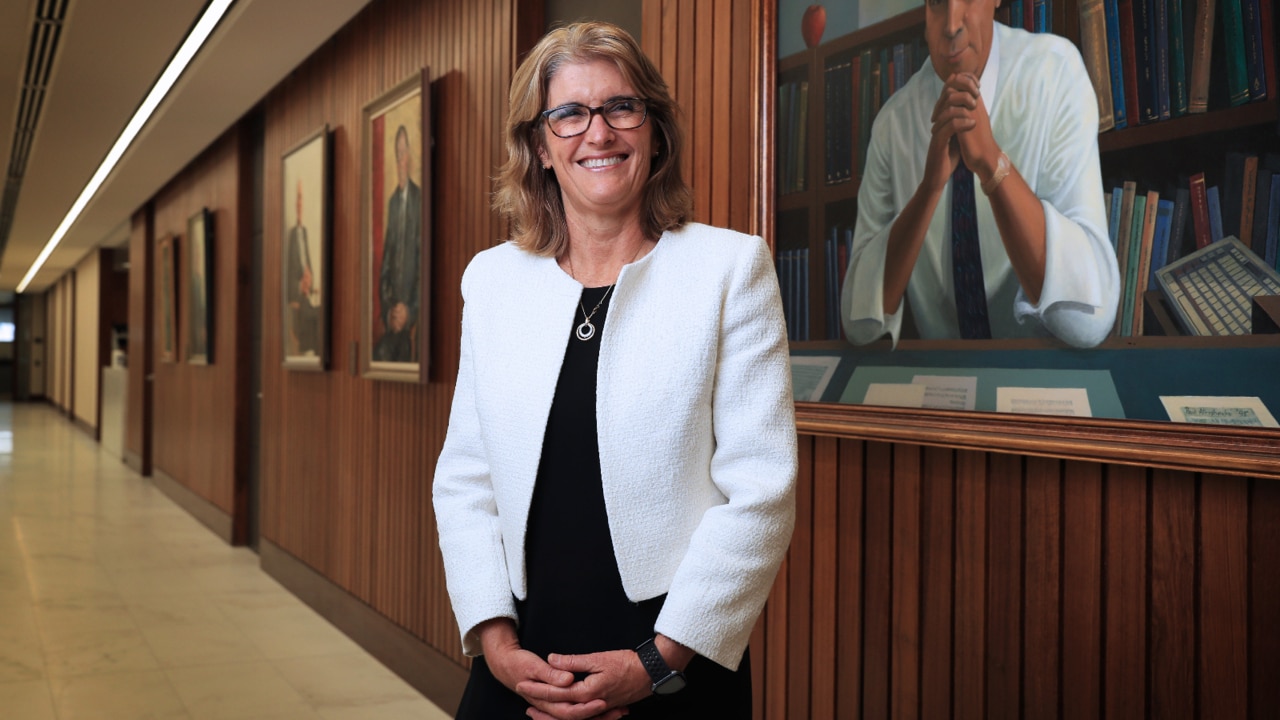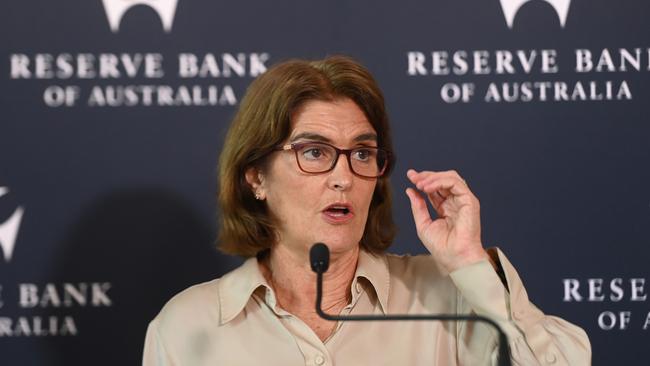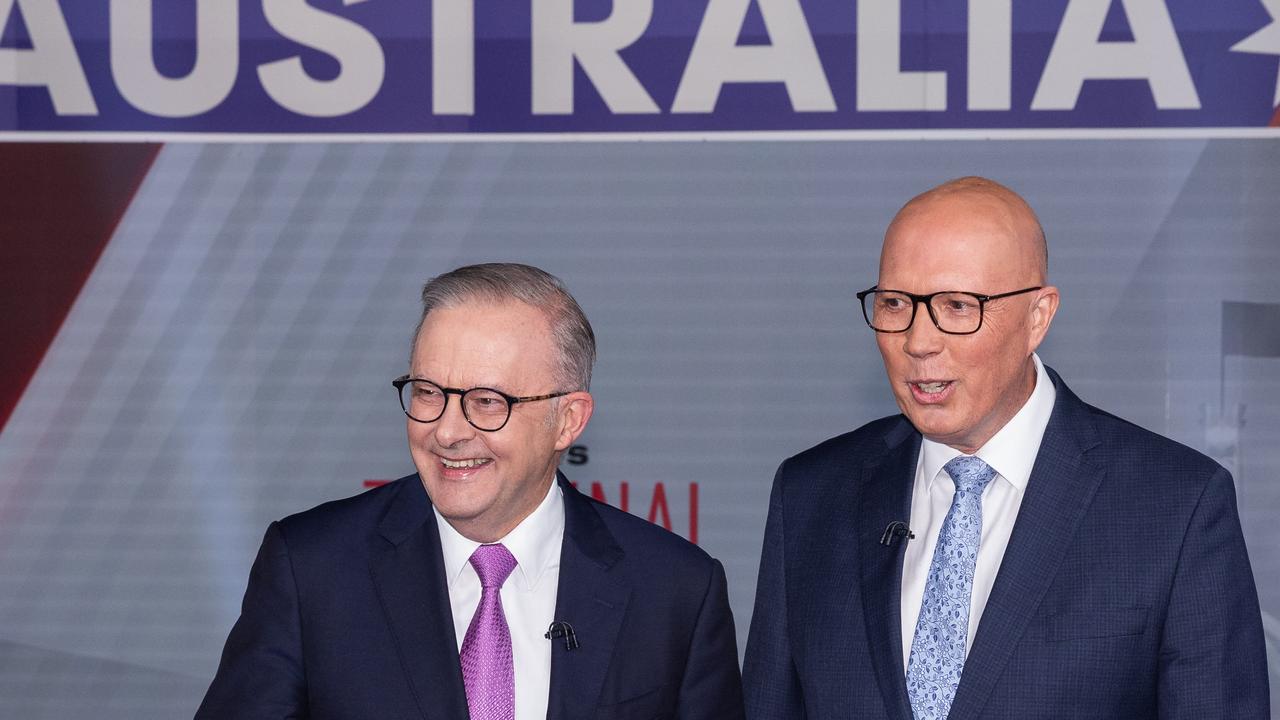RBA governor Michele Bullock changes tune on warning of future rate rises as union demands a cut
The RBA governor gave few clues on when households could expect rate relief - but there is one glimmer of hope for mortgage holders.

Interest Rates
Don't miss out on the headlines from Interest Rates. Followed categories will be added to My News.
A pivot from the Reserve Bank to scrap an explicit warning about further interest rate rises has the peak union body calling for the cash rate to be cut now.
The central bank kept the cash rate on hold for a third straight meeting on Tuesday at 4.35 per cent, as it awaits more evidence that a sharp downturn in inflation will continue.
But unlike previous statements, the board made no explicit mention of the possibility of an additional increase in interest rates, suggesting its aggressive run of 13 rate increases may have ended.
“The path of interest rates that will best ensure that inflation returns to target in a reasonable time frame remains uncertain and the board is not ruling anything in or out,” the statement read.
The statements following previous meetings have been more direct, stating: “A further increase in interest rates cannot be ruled out.”
Speaking later, Governor Michele Bullock was quick to downplay the change in sentiment.
“We have changed the language, that’s true, but that was in response to some data, which has demonstrated to us that we are still broadly on the path we thought we were on,” Ms Bullock told reporters.
Australian Council of Trade Union secretary Sally McManus said the RBA should now move to cut rates sooner rather than later.

But she welcomed the “subtle change” in language from the central bank while warning against future rate rises.
“We think that the last interest rate rise that they made at the end of last year wasn’t necessary, in our view, and we are just cautioning any move that’s going to put unemployment up further is also going to hurt people,” she told ABC Radio.
Inflation is already going down due to the “enormous pressure and pain” households are experiencing, Ms McManus said.
“We think the economy has already slowed and is hurting people too much. And it is not within their mandate to be driving up unemployment to that degree,” she said.
“At the moment unemployment is 4.1 per cent and we’ve got growing underemployment and that means people are not getting enough hours that they need.
“Effectively, they are saying they want to drive up unemployment further as a means of further slowing the economy.”
Ms Bullock added that while the central bank had made progress in its fight against inflation, the RBA was still not in a position to cut rates.
“What we need is greater confidence that inflation will return to the target band in a reasonable time frame and will stay there,” she said.
“The war isn’t yet won, so we continue to be vigilant.”
Westpac chief economist and former RBA assistant governor Luci Ellis said the board would “most likely remain on hold for a while”.
“What remains in the media release are the words of a central bank that is on hold, but not quite willing to say so outright,” Dr Ellis said.
“By saying it is not ruling anything in or out, the board is flagging the possibility that some shock could still derail the current trajectory of declining inflation and require a rate hike.
“But there is no sign of this occurring.”
‘Likely step’ towards rate cuts but services still sticky
Following the decision, rates traders pulled forward their bets of rate cuts, with markets implying a 96 per cent chance of easing to 4.1 per cent at the RBA’s August meeting.
AMP chief economist Shane Oliver agreed the RBA’s pivot to a neutral bias represented a “likely step” towards cutting rates.
“As the governor noted last month, it does not have to wait before inflation is actually back at target before starting to cut,” Dr Oliver said.
“Inflation is a lagging indicator and waiting till its back at target is likely a recipe for recession and inflation then falling below target.”
Data released since the RBA’s previous meeting in February have demonstrated a further cooling in the economy.
In January, Australia’s monthly inflation indicator eased to 3.4 per cent and the jobless rate rose to 4.1 per cent, while fresh GDP numbers showed the country’s economy expanded by just 0.2 per cent in the December quarter.
However, some economists have pointed to substantial wage increases, including in the aged care sector, and to stubborn services inflation could make future progress on reducing inflation difficult.
“Services inflation is still elevated, and that’s proving difficult to get down,” Ms Bullock warned.
HSBC chief economist Paul Bloxham said the increase in unit labour costs – the gulf between productivity and wages – was “far too high” to be consistent with the RBA’s inflation 2 to 3 per cent target.
“The challenge here is that, while wages growth lifting to around its current rate would not typically be worryingly high, it has coincided with dismal productivity outcomes in Australia,” Mr Bloxham said, who does not predict the bank will cut rates until 2025.
Reacting to the announcement, Treasurer Jim Chalmers hailed the decision as a reflection of the “good progress” made in taming inflation.
“It gives us confidence that inflation is moderating in welcome and encouraging wages,” Dr Chalmers told question time.
His opposition counterpart, Angus Taylor, said the decision would come as “cold comfort” for households.
“The reality is, Australians’ living standards have collapsed by thousands of dollars. This is money they will never get back, and there is no sign the government is committed to reversing this situation,” Mr Taylor said.
The RBA will release its latest financial stability review on Friday which will detail how household borrowers are weathering elevated interest rates.
Originally published as RBA governor Michele Bullock changes tune on warning of future rate rises as union demands a cut




